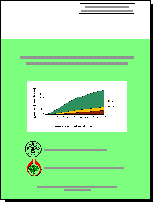

Carbon Dioxide Offset Investment in the Asia-Pacific Forestry Sector
Opportunities and Constraints
Field Document No.53, RAP Publication: 1998/9
| Table of Contents |
 Growing concern about the effects of climate change has led to increasing research, policy initiatives, and development of innovative programs and projects around the world. Developing policy, program and project measures that reduce human-induced greenhouse gas (GHG) emissions (i.e., CO2, N20 and chlorofluorocarbons [CFCs]) are of particular interest.
Growing concern about the effects of climate change has led to increasing research, policy initiatives, and development of innovative programs and projects around the world. Developing policy, program and project measures that reduce human-induced greenhouse gas (GHG) emissions (i.e., CO2, N20 and chlorofluorocarbons [CFCs]) are of particular interest.
Storing carbon in trees and forests is one option for offsetting the gases released by fossil fuel burning, and for mitigating the potential effects of global warming. Under the Kyoto Protocol negotiated in December 1997, recognition is given to this option. Countries that have agreed to specific greenhouse gas emission limits will be eligible to receive credit for certain domestic forestry and land-use activities that increase the storage of carbon in sinks. Moreover, under the Kyoto Protocol, countries will be able to earn emission reduction credits by carrying out collaborative carbon-storage activities in other countries. These credits, in turn, can be used to "offset" greenhouse gas emissions in their home countries to partially meet emission reduction commitments. In this report "carbon offset" project activities are referred to as certified Emission Reduction Credits (ERC).
Numerous issues related to the new international negotiations and agreements remain unclear, however. Many questions remain over the economics, politics, and mechanisms under which the new agreements will be implemented. Nonetheless, it is apparent that forestry could play a significant role in the global strategy for mitigating the threat of global climate change. This report discusses opportunities and constraints in forest sector ERC projects in the Asia-Pacific Region.
The report discusses wood energy development as one of the options for ERCs. In fact, the global climate will benefit twice if the investments are directed to plantations that supply wood energy. First, by initial carbon sequestration when the trees are growing, and second, by avoiding emissions when the trees are used as a source of wood energy on a sustainable basis. The second effect reflects common practice in Asia.
The report is a joint publication of RWEDP and FAO's Regional Office for Asia and the Pacific.
| Table of Contents | |
| Foreword | |
| 1. | Introduction |
| 2. | Perspectives and Responses |
| 3. | Opportunities and Constraints in the Asia-Pacific Forestry Sector |
| 4. | Emerging Prospects and Challenges for Forest Sector ERC Project Investment |
| 5. | Recommedations for Forest Sector ERC Investment |
| 6. | Future Prospects for Forest Sector ERC Project Investment |
| 7. | References |
This document is available as a single, complete file in Adobe Acrobat PDF format suitable for downloading, printing, duplication and distribution. (To download the free Acrobat Reader and find out how to use PDF files click here.)
Download this document (279KB)
Comments, questions? webmaster@rwedp.org
© FAO-RWEDP, 1999